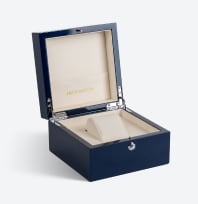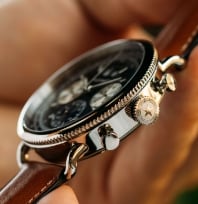From their inception in the 16th century up until the popularization of the wristwatch in the 20th Century, pocket watches were a staple of men’s fashion. What happened? Here, we’ll briefly discuss what gave pocket watches their staying power and explain why making a return to small pocket watches may be worth the investment.
Early History
Peter Henlein designed the first portable watches in the early sixteenth century, though here “portable” comes with a caveat: These early watches were large. So large, in fact, that they were intended to be worn on the neck like a pendant rather than carried in the pocket. Accuracy was also an issue: These early watches were not especially reliable, and as such, only told time to the hour.
Subsequent developments would streamline the components of the watch, including the use of jewels and oil to reduce the stress put on the components of the watch. Watches and watch components became both smaller and more accurate.
With the coming of the Industrial Revolution and railway travel, the pocket watch became increasingly necessary in day-to-day living. In the context of their invention, pocket watches were traditionally attached using a chain made of some precious material to the wearer's vest or waistcoat, but contemporary usage also has seen them attached to the loops of a pair of pants.
Pocket watches trended smaller for the same reason men’s dress watches trend smaller than sports contemporaries. They are meant to provide a dash of allure as a practical accessory without rumpling the silhouette of the wearer.
Functionally, some pocket watches became known as “railroad watches” because, as alluded to before, they became so precise in their movements that conductors began using them, as certain watches superseded the accuracy of their onboard systems.
Types of Pocket Watches
Though wristwatches showcase a wider range of complications compared to their pocket-based counterparts, pocket watches have a wider range of construction methods. While wristwatches are typed based on the function they serve, pocket watch types are separated based on the design of the case itself.
-
Full Hunter: In this type of pocket watch, the face of the watch is protected by an attached outer case, which can often be released on one side by pushing in the crown. While this offers maximum protection, it also makes it time-consuming if one needs to regularly check the time.
-
Half Hunter: Derived from the full hunter, the Half Hunter features an outer casing that provides a window from which the hands of the watch are visible, making it easy to check the time.
-
Double Hunter: Like the hunter, this type of pocket watch features an outer casing protecting the face. However, the double hunter also features a back casing, which can be released to reveal the mechanical workings of the watch.
When both front and back casings are removed, it is possible to leave the double hunter standing up, making it a perfectly serviceable desk clock.
-
Double Half Hunter: This type of watch features the double-cased properties of the double hunter, as well as the legibility window of the half hunter.
- Open Face: This design choice has no covering. While this leaves the crystal of the watch exposed, it has the benefit of allowing easy reading of the time. The overwhelming majority of contemporary wristwatches showcase this kind of style.
A Competitor Arises
In the 20th century, a series of military conflicts would cause the wristwatch to become popularized and mass-produced, leading to it supplanting the pocket watch. The earliest military wristwatches were actually pocket watches modified to be strapped to the wrist. A bit of trivia: During World War I, some wristwatches with half hunter faces were designed to ensure the protection of the timepiece while still making it easy for soldiers to keep time.
After mass-production of wristwatches arose in response to wartime demand, they began to gather popular appeal as well. Wristwatches were convenient, and in several cases, they had the benefit of being more affordable than their pocket-based counterparts.
Stylish and practical wristwatches are much more popular than pocket watches in today’s world. However, those who swear by the pocket watch are not entirely uncommon to come by for a variety of reasons.
Size Matters
All sorts of things determine the size of a watch. Larger watches have more leeway in terms of the internal construction and assemblage of their pieces. This can mean larger sets of gears or wheels, or it can mean the existence of additional complications such as chronographs.
Thinner watches have less room for the watchmaker to maneuver, meaning that by necessity, a greater deal of precise, fine-tuned design is required to keep the watch functional.
Do pocket watches differ in size compared to their wrist-based counterparts? Examining a list of typical pocket watch sizes with the measurement taken from the movement reveals an interesting trend.
While the upper limit doesn’t radically exceed what’s normally seen in a wristwatch (56mm, whereas the upper limit for common men’s wristwatches is in the upper 40s), the lowest limit is a strikingly small 20.32mm. Common sizes for men start at 38mm. However, many dress watches, which may be the first thing that comes to mind when picturing a pocket watch, run smaller than that.
Advantages of a Small Pocket Watch: Function
Much can be said about the benefits of a small pocket watch that would be true of any pocket watch. Nay-sayers may call the trend dated, but every powerful statement, whether it be fashion-related or otherwise, will have contrarians to speak against it.
Here is a list of pocket watches’ functional appeal:
-
Pocket Watches Maintain Value: While sentimental and historical value may trump financial when leaving something behind, the fact remains that well-cared-for watches are commonly a high-ticket item at specialized auctions. This makes an heirloom potentially as economically valuable as it is emotionally.
-
You Value Classic Movements: Quartz, mechanical, and automatic movements are all popular for various reasons, but only the latter two showcase the delicate machinery which has helped maintain the popularity of watches for connoisseurs. Pocket watches, antique ones, in particular, rely more on these movements to provide the value of intricate clockwork.
-
Distinction: A watch isn’t like a shirt; unless you happen to be a serious collector, it’s doubtful you have dozens of watches to be changed out on a whim. A watch should set itself apart from other watches and set you apart from other watch-wearers.
What better way to do that than buck the trend of what everyone else is wearing and go with a classic timepiece that’s sure to cause a conversation or two?
- Versatility: Because the pocket watch features three components: The watch, the chain, and an optional decorative fob, there are plenty of ways you can wear it. You can go a traditional manner and keep it attached to a vest button while leaving the watch protected in your pocket, or you can take inspiration from James Dean and let a small timepiece dangle from a loop in your pants.
Advantages of a Small Pocket Watch: Aesthetics
Here is a list of pocket watches’ aesthetic appeal:
-
Engage with Vintage Fashion: It’s fairly easy to find a low-cost, gorgeous antique pocket watch. Because pocket watches were traditionally hand-made and built to last as a legacy piece, it’s no hassle to locate older, used watches via online retailers or private sellers.
You can even find local antique sellers with at least a few timepieces in stock. Purchasing a watch either in person or from a reputable dealer is the best way to make sure your antique timepiece is everything you want it to be.
-
Craftsmanship: On a functional level, watches tell time and perform any other number of tasks. But the aspect which gave them their reputation as a status symbol and as a fashion icon is the precision craftsmanship that goes into them.
A pocket watch is the result of attention to detail in both manufacturing and, for antiques, maintenance. A small watch, in particular, is a mark of highly detailed effort on the part of the watchmaker, requiring smaller gears and efficient use of every square millimeter of space the watch has to offer.
- Legacy: A watch can last a lifetime, but a well-made watch should last several. A pocket watch can make a touching heirloom to pass on. You can decorate the case of the watch, depending on the type, with a photograph inset on the interior of the case or an initial engraving on the exterior. This allows for a vintage pocket watch a beautiful embellishment with real, sentimental value.
The Final Reason For Wearing a Small Pocket Watch
Why do anything? The answer is, of course: Because you want to. You’re wearing the watch, not vice versa, and for that reason, you choose to wear one that best represents you. A pocket watch is distinctive. A pocket watch is classy. A pocket watch harkens to the highest ideals of elegance and traditionalism while presenting a maverick.
Sources:
James Dean's Pocket Watch Up for Auction I Business Insider
Peter Henlein and “The Immortal Heart” | Deutsches Uhrenmuseum











